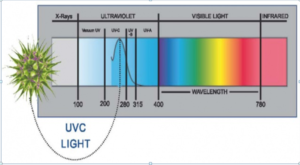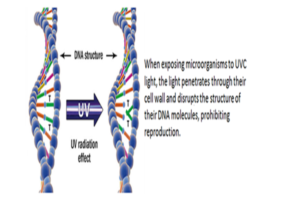What is Ultraviolet?
Ultraviolet (UV) light is one form of electromagnetic energy produced naturally by the sun. UV is a spectrum of light just below the visible light and it is split into four distinct spectral areas – Vacuum UV or UVV (100 to 200 nm), UVC (200 to 280 nm), UVB (280 to 315 nm) and UVA (315 to 400 nm).

What is Ultraviolet C?
The entire UV spectrum can kill or inactivate many microorganism species, preventing them from replicating. UVC energy at 253.7 nanometers provides the most germicidal effect. The application of UVC energy to inactivate microorganisms is also known as Germicidal Irradiation or UVGI.

UVC exposure inactivates microbial organisms such as bacteria and viruses by altering the structure and the molecular bonds of their DNA (Deoxyribonucleic acid). DNA is a “blueprint” these organisms use to develop, function, and reproduce. By destroying the organism’s ability to reproduce, it becomes harmless since it cannot colonize. After UVC exposure, the organism dies off leaving no offspring, and the population of the microorganism diminishes rapidly.
Ultraviolet germicidal lamps provide a much more powerful and concentrated effect of ultraviolet energy than can be found naturally. Germicidal UV provides a highly effective method of destroying microorganisms.
What is Germicidal UV?
Germicidal ultraviolet (GUV) – refers to short-wavelength ultraviolet radiant energy that has been shown to kill bacteria and to inactivate viruses. Wavelengths in the ultraviolet band known as the “UV-C” (from 200 to 280nm), have been shown to be the most effective for disinfection.
How does GUV work to inactivate a virus?
On a microscopic level, individual, UV-C photons interact with the RNA and DNA molecules in viruses and bacteria to render them non-infectious.
How do we know it works and in particular for viruses?
The dose required to achieve 1-log killing is often called the D90-value (where 90% of the pathogen is killed), and these values have been empirically determined for many pathogens and microorganisms (see for instance, Kowalski -2017).
UVC has been demonstrated to work very effectively to inactivate viruses including coronaviruses. Darnell et al. – 2004 showed that UVC exposure resulted in >5 log reduction of SARS-CoV.
Will GUV work on the SARS-CoV-2 (COVID-19)?
The SARS-CoV-2 virus has not yet been specifically tested for its ultraviolet susceptibility but many other tests on related coronaviruses, including the SARS coronavirus, have demonstrated they are highly susceptible to ultraviolet inactivation. The International Ultraviolet Association (IUVA) has assembled leading experts from around the world to develop guidance on the effective use of UV technology, as a disinfection measure, to help reduce the transmission of the SARS-CoV-2 virus.
Is GUV the same as “Near UV” solutions others are currently providing?
No. GUV is a different wavelength and is classified as UV-C. Near UV (405nm) is in the visible wavelength.
While GUV will inactivate a virus, near UV has no measurable effect on viruses. Near UV has been shown to be effective on surface bacteria when exposed for long durations.
Is GUV Safe?
GUV poses a health hazard to the eyes and skin if the lamps are improperly used or installed.
If these are not “light” then how do you know it is on?
Like odor added to natural gas, the GUV source does have some emission that is visible so that you can see when it is on.
Does this replace the need for cleaning?
No. While UVGI has been shown to be an excellent surface disinfectant, it does not penetrate surfaces and cannot disinfect dirty surfaces. The inability of the UV radiant energy to reach shadowed recesses of surfaces or to penetrate dust and other matter may negatively affect disinfection. For these reasons, GUV is typically used as a supplement to other disinfection processes. “Enforcement Policy for Sterilizers, Disinfectant Devices, and Air Purifiers During the Coronavirus Disease (COVID-19) Public Health Emergency Guidance for Industry and Food and Drug Administration Staff”. (Source: fda.gov)
Can we use this to clean PPE?
While it has been shown to disinfect, the use on PPE is early and should follow procedures to ensure product integrity is maintained. Since all materials for PPE are different, we recommend following PPE manufacturers guidelines.
What technology is used for GUV?
There are both low-pressure discharge “pin-based” and LED solutions available.
The LED solutions, however, are limited, and the efficiency is orders of magnitude lower than GUV.
The CLS solution will use bi-pin sources and specialized materials to maximize the power distribution of the GUV.
How does this light affect artifacts in the room?
Prolonged exposure to GUV will degrade paint, yellow plastics, and dull the surface finish of shiny objects.
How do we determine the number of sources and energy required to effectively disinfect an area?
Similar to light energy, we have models showing the GUV power which is affected by the distance from the source.
Similar to lighting layouts, we can translate this into power delivered to an area.
The power can be translated to time to eliminate a particular pathogen based on its “recipe” to eliminate 99.99% from the disinfected surface.
